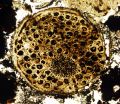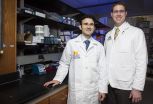(Press-News.org) A Virginia Tech geobiologist with collaborators from the Chinese Academy of Sciences have found evidence in the fossil record that complex multicellularity appeared in living things about 600 million years ago – nearly 60 million years before skeletal animals appeared during a huge growth spurt of new life on Earth known as the Cambrian Explosion.
The discovery published online Wednesday in the journal Nature contradicts several longstanding interpretations of multicellular fossils from at least 600 million years ago.
"This opens up a new door for us to shine some light on the timing and evolutionary steps that were taken by multicellular organisms that would eventually go on to dominate the Earth in a very visible way," said Shuhai Xiao, a professor of geobiology in the Virginia Tech College of Science. "Fossils similar to these have been interpreted as bacteria, single-cell eukaryotes, algae, and transitional forms related to modern animals such as sponges, sea anemones, or bilaterally symmetrical animals. This paper lets us put aside some of those interpretations."
In an effort to determine how, why, and when multicellularity arose from single-celled ancestors, Xiao and his collaborators looked at phosphorite rocks from the Doushantuo Formation in central Guizhou Province of South China.
They recovered three-dimensionally preserved multicellular fossils that showed signs of cell-to-cell adhesion, differentiation, and programmed cell death — qualities of complex multicellular eukaryotes such as animals and plants.
The discovery sheds light on how and when solo cells began to cooperate with other cells to make a single, cohesive life form.
The complex multicellularity evident in the fossils is inconsistent with the simpler forms such as bacteria and single-celled life typically expected 600 million years ago.
While some hypotheses can now be discarded, several interpretations may still exist, including the multicellular fossils being transitional forms related to animals or multicellular algae.
Xiao said future research will focus on a broader paleontological search to reconstruct the complete life cycle of the fossils.
INFORMATION:
Xiao earned his bachelor's and master's degrees from Beijing University in 1988 and 1991 and his doctoral degree from Harvard University in 1998. He worked for three years at Tulane University before arriving at Virginia Tech in 2003.
He is currently active in an editorial role for seven professional publications and has published more than 130 papers.
More resources are available at Virginia Tech News.
Fossil of multicellular life moves evolutionary needle back 60 million years
Virginia Tech researcher finds evidence of cellular complexity eras earlier than expected
2014-09-25
ELSE PRESS RELEASES FROM THIS DATE:
NCI/FDA lung cancer workshop leads to the innovatively designed clinical trials
2014-09-25
DENVER – The recent launch of two clinical trials offer innovative study designs for patients with lung cancer. These clinical trials are the direct result of a National Cancer Institute (NCI) sponsored workshop chaired by Drs. Fred R. Hirsch, Shakun Malik and Claudio Dansky- Ullman, that brought together the NCI Thoracic Malignancies Steering Committee, the US Food and Drug Administration (FDA), academicians, clinicians as well as industry and government stakeholders to discuss issues and challenges related to clinical trial design and biomarkers for lung cancer targeted-therapies.
The ...
Treatment studied to help patients 'burned to the bone'
2014-09-25
An anti-inflammatory treatment, studied in the labs of regenerative medicine specialists and trauma surgeons, may prevent what's become one of the war-defining injuries for today's troops.
Those burned by high-velocity explosive devices are at-risk for heterotopic ossification (HO), in which bone develops in places it shouldn't be, outside the skeleton, in joints, muscles and tendons. The painful condition can make it difficult to move and function and commonly affects patients who suffer burns, automobile accidents, orthopedic surgery and blast injuries and other combat ...
Live long and phosphor: Blue LED breakthrough for efficient electronics
2014-09-25
ANN ARBOR—In a step that could lead to longer battery life in smartphones and lower power consumption for large-screen televisions, researchers at the University of Michigan have extended the lifetime of blue organic light emitting diodes by a factor of 10.
Blue OLEDs are one of a trio of colors used in OLED displays such as smartphone screens and high-end TVs. The improvement means that the efficiencies of blue OLEDs in these devices could jump from about 5 percent to 20 percent or better in the near future.
OLEDs are the latest and greatest in television technology, ...
Study finds global sea levels rose up to 5 meters per century at the end of the last 5 ice age
2014-09-25
Land-ice decay at the end of the last five ice-ages caused global sea-levels to rise at rates of up to 5.5 metres per century, according to a new study.
An international team of researchers developed a 500,000-year record of sea-level variability, to provide the first account of how quickly sea-level changed during the last five ice-age cycles.
The results, published in the latest issue of Nature Communications, also found that more than 100 smaller events of sea-level rise took place in between the five major events.
Dr Katharine Grant, from the Australian National ...
Calming down immune cells could hold key to melanoma treatment
2014-09-25
Immune cells may be responsible for drug resistance in melanoma patients, according to research published in Cancer Discovery.
Cancer Research UK scientists at The University of Manchester found that chemical signals produced by a type of immune cell, called macrophages, also act as a survival signal for melanoma cells.
When the researchers blocked the macrophages' ability to make this signal - called TNF alpha - melanoma tumours were much smaller and easier to treat.
When melanoma patients are given chemotherapy or radiotherapy it causes inflammation, increasing ...
Interactive website helps lower-income smokers to stop smoking
2014-09-25
People with lower incomes attempting to quit smoking are 36% more likely to succeed if they use a new interactive website called 'StopAdvisor' than if they use a static information website, finds a randomised controlled trial led by UCL researchers. The trial was funded by the National Prevention Research Initiative, a consortium of 16 UK health research funders.
A total of 4,613 smokers took part in the study, of whom 2,142 were classified into a 'lower income' group who had never worked, were long term unemployed or from routine or manual occupations (lower socioeconomic ...
Skirt size increase linked to 33 percent greater postmenopausal breast cancer risk
2014-09-25
Overall weight gain during adulthood is known to be a risk factor for breast cancer, but a thickening waist seems to be particularly harmful, indicating the importance of staving off a midriff bulge, the research shows.
The researchers base their findings on almost 93,000 women taking part in the UK Collaborative Trial of Ovarian Cancer Screening (UKCTOCS) in England.
The women were all aged over 50, had gone through the menopause, and had no known breast cancer when they entered the study between 2005 and 2010.
At enrolment they provided detailed information on height ...
The Lancet Diabetes & Endocrinology: Working long hours linked to increased risk of type 2 diabetes
2014-09-25
People working for more than 55 hours per week doing manual work or other low socioeconomic status jobs have a 30% greater risk of developing type 2 diabetes, according to the largest study in this field so far, published in The Lancet Diabetes & Endocrinology.
Mika Kivimäki, Professor of Epidemiology at University College London, UK, and colleagues conducted a systematic review and meta-analysis of published studies and unpublished individual-level data examining the effects of long working hours on type 2 diabetes up to 30 April 2014.
Analysis of data from 4 published ...
Identification of genetic risk factors for stroke
2014-09-25
Stroke is one of the leading causes of death worldwide. While many lines of evidence suggest that stroke risk is heritable, only a small number of genes associated with stroke have been identified. A new study in the Journal of Clinical Investigation identifies two genes that underlie cerebral small-vessel disease (CSVD), a risk factor for stroke. Ordan Lehmann and colleagues at the University of Alberta analyzed genome-wide association data from individuals that received brain MRI scans as part of the Cohorts for Heart and Aging Research in Genomic Epidemiology (CHARGE) ...
Wound healing response promotes breast cancer metastasis in postpartum mice
2014-09-25
Within the first 5 years after the birth of a child, women are at an increased risk of developing metastatic breast cancer. Women diagnosed with postpartum breast cancer have a decreased disease free survival time compared to women that have never given birth. The aggressive tendency of postpartum breast cancer suggests that the post-birth breast environment promotes tumor metastasis. A new study in the Journal of Clinical Investigation, suggests that dying tumor cells in postpartum breast tissue promote metastatic disease. Rachel Cook and colleagues at Vanderbilt University ...
LAST 30 PRESS RELEASES:
ASH 2025: AI uncovers how DNA architecture failures trigger blood cancer
ASH 2025: New study shows that patients can safely receive stem cell transplants from mismatched, unrelated donors
Protective regimen allows successful stem cell transplant even without close genetic match between donor and recipient
Continuous and fixed-duration treatments result in similar outcomes for CLL
Measurable residual disease shows strong potential as an early indicator of survival in patients with acute myeloid leukemia
Chemotherapy and radiation are comparable as pre-transplant conditioning for patients with b-acute lymphoblastic leukemia who have no measurable residual disease
Roughly one-third of families with children being treated for leukemia struggle to pay living expenses
Quality improvement project results in increased screening and treatment for iron deficiency in pregnancy
IV iron improves survival, increases hemoglobin in hospitalized patients with iron-deficiency anemia and an acute infection
Black patients with acute myeloid leukemia are younger at diagnosis and experience poorer survival outcomes than White patients
Emergency departments fall short on delivering timely treatment for sickle cell pain
Study shows no clear evidence of harm from hydroxyurea use during pregnancy
Long-term outlook is positive for most after hematopoietic cell transplant for sickle cell disease
Study offers real-world data on commercial implementation of gene therapies for sickle cell disease and beta thalassemia
Early results suggest exa-cel gene therapy works well in children
NTIDE: Disability employment holds steady after data hiatus
Social lives of viruses affect antiviral resistance
Dose of psilocybin, dash of rabies point to treatment for depression
Helping health care providers navigate social, political, and legal barriers to patient care
Barrow Neurological Institute, University of Calgary study urges “major change” to migraine treatment in Emergency Departments
Using smartphones to improve disaster search and rescue
Robust new photocatalyst paves the way for cleaner hydrogen peroxide production and greener chemical manufacturing
Ultrafast material captures toxic PFAS at record speed and capacity
Plant phenolic acids supercharge old antibiotics against multidrug resistant E. coli
UNC-Chapel Hill study shows AI can dramatically speed up digitizing natural history collections
OYE Therapeutics closes $5M convertible note round, advancing toward clinical development
Membrane ‘neighborhood’ helps transporter protein regulate cell signaling
Naval aviator turned NPS doctoral student earns national recognition for applied quantum research
Astronomers watch stars explode in real time through new images
Carbon-negative building material developed at Worcester Polytechnic Institute published in matter
[Press-News.org] Fossil of multicellular life moves evolutionary needle back 60 million yearsVirginia Tech researcher finds evidence of cellular complexity eras earlier than expected

